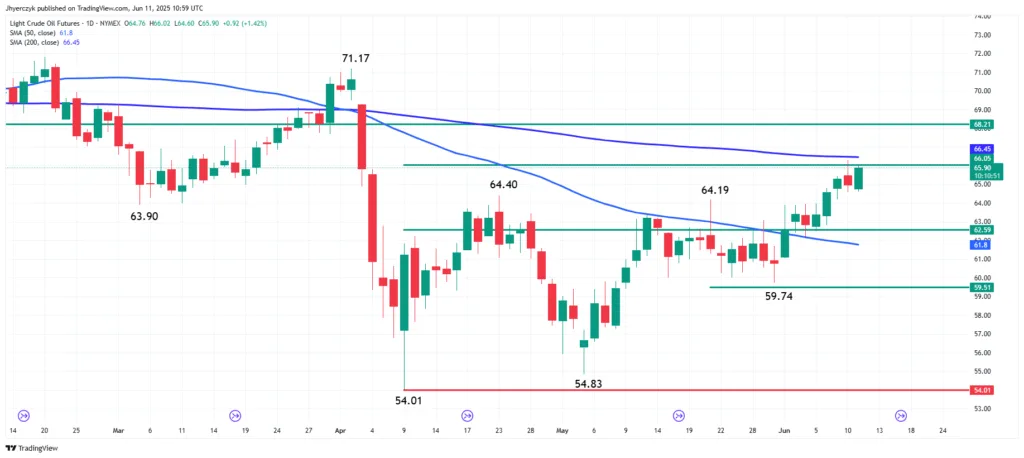
Oil markets are heating up as growing geopolitical risks support WTI futures’ ongoing testing of key resistance levels. Although prices eased after briefly touching $66.28, traders are still keeping their eyes on the 200-day moving average at $66.45. Thus, oil prices are rising as a result of OPEC+’s increased output, improving trade negotiations between the US and China, and growing tensions with Iran. Therefore, a confirmed breakout may lead to additional gains.
WTI Futures Build Momentum Despite Supply Concerns
WTI futures move closer to the $66.45 resistance level for a second day of upward movement. Despite not closing above the key level, the move suggests that bullish interest has returned. If a clean breakout occurs, prices may rally to $68.21. If sellers regain control, $63.09 will serve as critical support.
Additionally, OPEC+ has declared a 411,000 barrel per day increase in production for July. Nevertheless, experts warn that domestic summer demand, particularly in Saudi Arabia, may offset the additional supply.
Geopolitical Risks Reinforce Oil Price Outlook
Tensions between the US and Iran are once again escalating geopolitical risks. The market is more concerned now because of President Trump’s skepticism about Iran’s uranium program. So, WTI futures are now more risky due to Tehran’s threats to strike American bases. Traders are anticipating potential disruptions.
Meanwhile, sentiment is rising as a result of a new trade agreement between the US and China. Additionally, by reviving negotiations and relaxing export restrictions on rare earths, the agreement has increased risk appetite overall. As a result, WTI futures reached a seven-week high.
However, it remains unclear how much trade progress will translate into increased demand. PVM’s Tamas Varga warned that enthusiasm may not be enough to ensure real growth. Even as bullish technical signals have emerged, this sentiment has maintained the volatility of oil prices.
Crude Inventory Trends Could Shift Short-Term Moves
After preliminary API data indicated a draw of 370,000 barrels last week, markets are now awaiting official EIA data. In particular, the anticipated 2.4 million barrels could push WTI futures past resistance if a larger draw is confirmed. As a result, traders are paying close attention to this figure, which reflects strong demand.
The amount of crude inventory is still a major driver. Bulls are more inclined to take long positions when declines indicate a tighter supply. On the other hand, an unexpected increase might weaken confidence and cause a retreat. It will probably be a make-or-break moment when the EIA is released. The trend in crude inventory may sustain long-term increases in oil prices if draws meet expectations.
Bullish Bias Builds as Oil Prices Test Key Resistance
A new rally could begin if WTI futures can break and stay above $66.45. The bias is still favorable due to factors like declining crude inventories, increasing geopolitical risks, and waning trade worries. However, a retest of the $63 level might occur if resistance is not overcome.

Traders are cautiously optimistic about the future. If a breakout is confirmed, it would draw new buyers and push oil prices closer to the $68 handle. The outcome of the EIA inventory report and the course of geopolitical events will determine a lot.
Final Verdict
As momentum keeps increasing, the markets are at a turning point. It will probably be determined in the next 48 hours whether WTI futures confirm the breakout or encounter fresh resistance. If technical strength and important fundamentals line up, oil prices may move further into the $68–$70 range. Until then, the market’s prevailing sentiment is caution.







